Inside: Check out 24 garden edging ideas that’ll help you create clean, stylish borders for your lawn and flower beds. These easy design tips might just spark your next outdoor project.
Your garden edging really changes how your yard looks and feels. Garden edging defines spaces, keeps things tidy, and adds a polished vibe to your outdoor area.
Whether you like a modern or classic style, the right edging can give your garden that fresh, finished touch that makes it pop.

1. Classic Red Brick Border
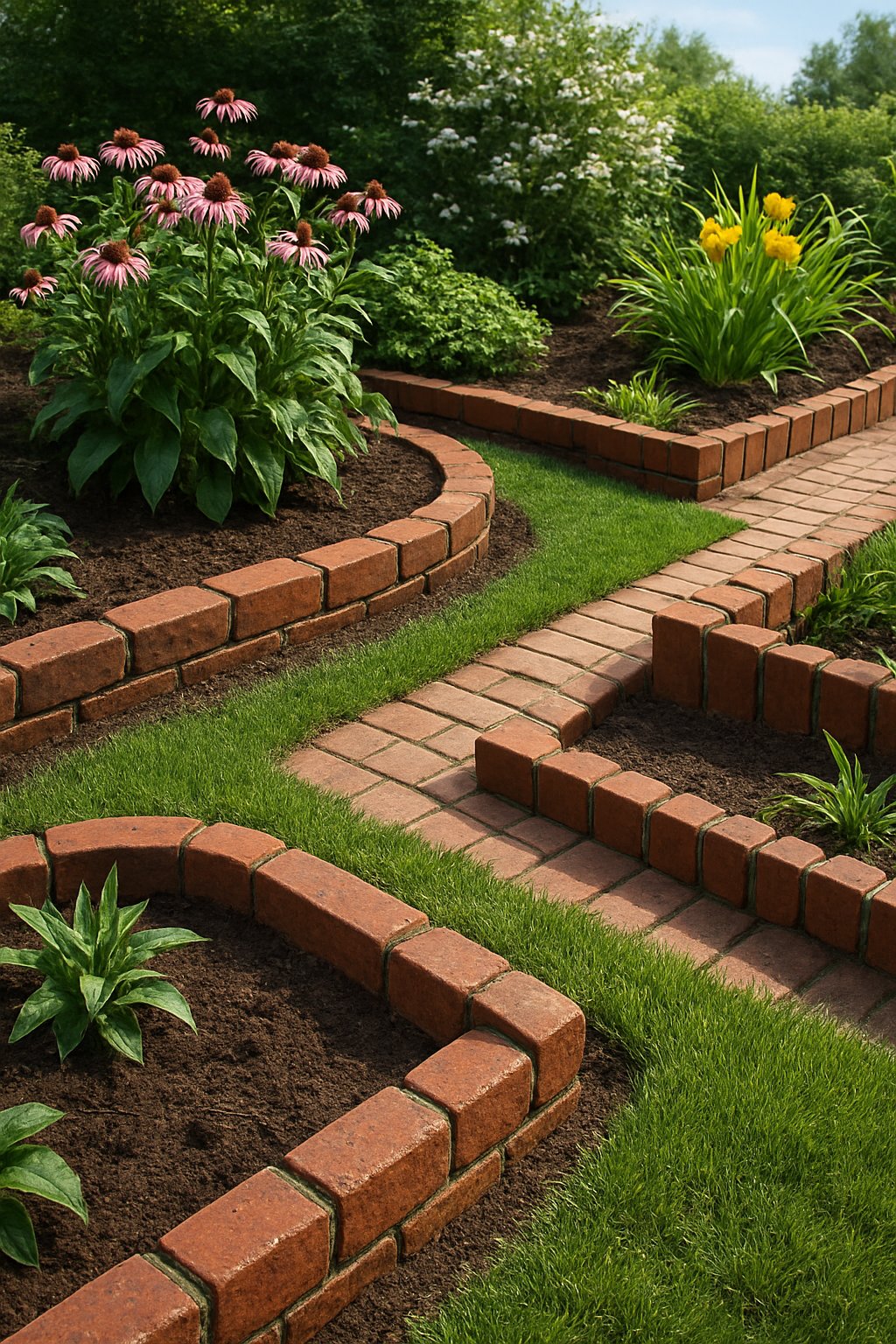
A red brick border never really goes out of style. It gives your garden a clean, neat look that fits with just about any style.
Lay the bricks flat or stand them up for a different vibe—both work well. Bricks keep grass and plants from wandering where you don’t want them.
They add a bit of height, making your garden beds feel more defined and organized. You can go for straight lines, or get creative and arrange bricks in patterns for more visual interest.
Red bricks look even better as they age, picking up character but holding up strong. This edging is affordable and, honestly, pretty simple to install.
If one cracks, just swap it out—no need to redo the whole border.
Expert Tip from MrPlanter: “Use sand to fill gaps between bricks for better stability and drainage. Seal the bricks to protect against weather and keep color vibrant longer.”
2. Smooth River Rock Edge

Smooth river rocks give your garden edging a natural, relaxed look. These stones come in all sorts of sizes and colors, so matching your style is easy.
You can line them up in a soft curve or a straight edge. River rocks are tough and do a good job of controlling soil erosion.
They let water flow through, which helps with drainage. Use this edging around flower beds, walkways, or even veggie gardens.
To put them in, dig a shallow trench along your border. Place the rocks close together for a tidy edge.
Mixing small and large stones adds texture and interest.
Expert Tip from MrPlanter: “Choose river rocks with a mix of colors to add depth to your edge. Lay them on landscape fabric to keep weeds from growing through.”
3. Recycled Wine Bottle Border
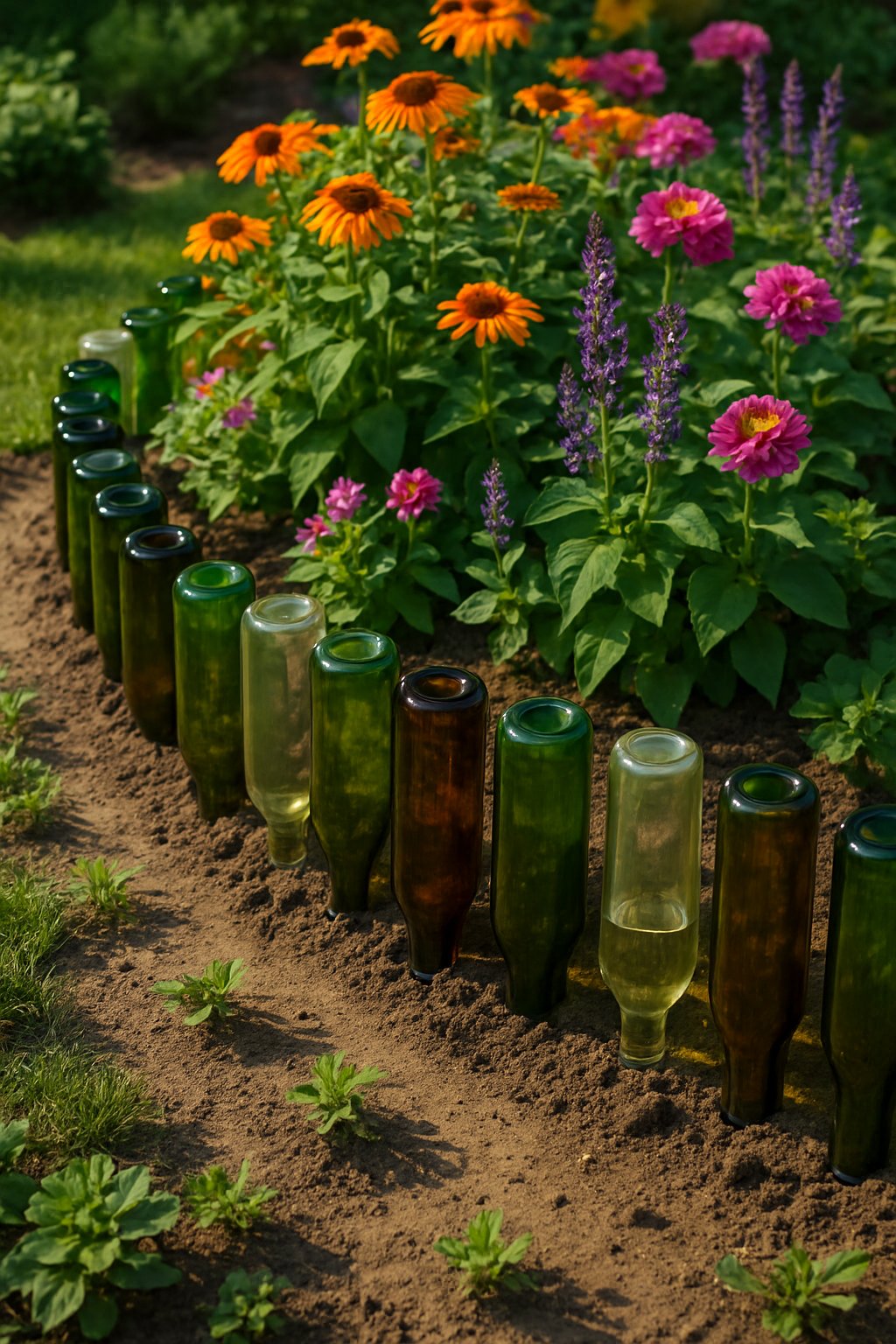
Using recycled wine bottles for edging? It’s quirky and fun. Bury them upside down with the bottoms showing for a colorful, unique border.
This works for flower beds or along paths. It’s eco-friendly, cuts down on waste, and you only need empty bottles, some dirt, and a bit of time.
The bottles naturally curve as you set them, giving your border a softer, more interesting look. Make sure you plant them firmly so they don’t tip over.
Mix different colored bottles for a playful pattern, or stick to clear ones for a subtle look. This border is low maintenance and keeps grass from sneaking into your beds.
It also helps hold soil in place. Plus, it’s a project you can do solo or with friends—maybe after a wine night?
Expert Tip from MrPlanter: “Choose bottles with even bottoms so they stay steady in the ground. Clean them well before placing to avoid pests and dirt buildup.”
4. Wooden Log Edging
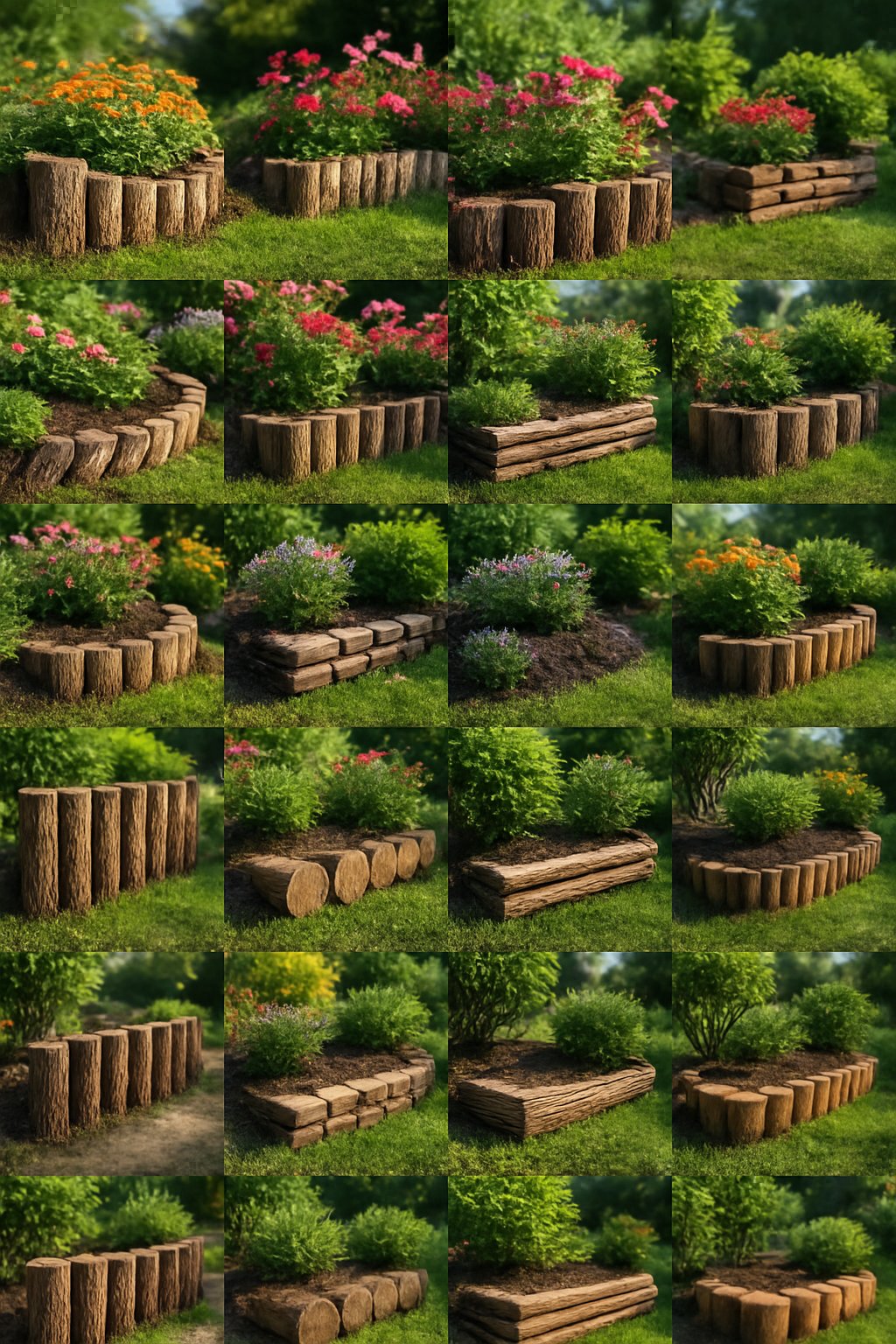
Wooden log edging brings a rustic look to your garden borders. Use old or freshly cut logs to make a simple barrier that blends right in with the plants.
You can stand logs up or lay them flat, whatever suits your style. It’s easy to shape them for curves or straight lines.
Treat logs with weatherproof sealant to help them last longer and keep them looking good. Using logs of different sizes gives your border a more natural, textured feel.
Mix thick and thin pieces for extra interest. This edging works for flower beds, paths, or veggie gardens.
It marks out spaces without making things look too harsh.
- DECORATIVE GARDEN BORDERS: Create a beautiful floral display in your garden and enhance your landscape curb appeal with...
- DURABLE & RESISTANT: Garden borders and edging made of natural Eucalyptus solid-log wood from South Africa are durable...
- Solid 2-Inch Logs: Each round log is made from thick, high-density pine and measures 2 inches in diameter—sturdy...
- Carbonized for Durability: The dark, rich finish enhances both the appearance and weather resistance—no extra paint or...
Expert Tip from MrPlanter: “Choose logs from hardwood for better durability in your garden. Seal the wood before planting close to prevent moisture damage.”
5. Metal Garden Edging Strips
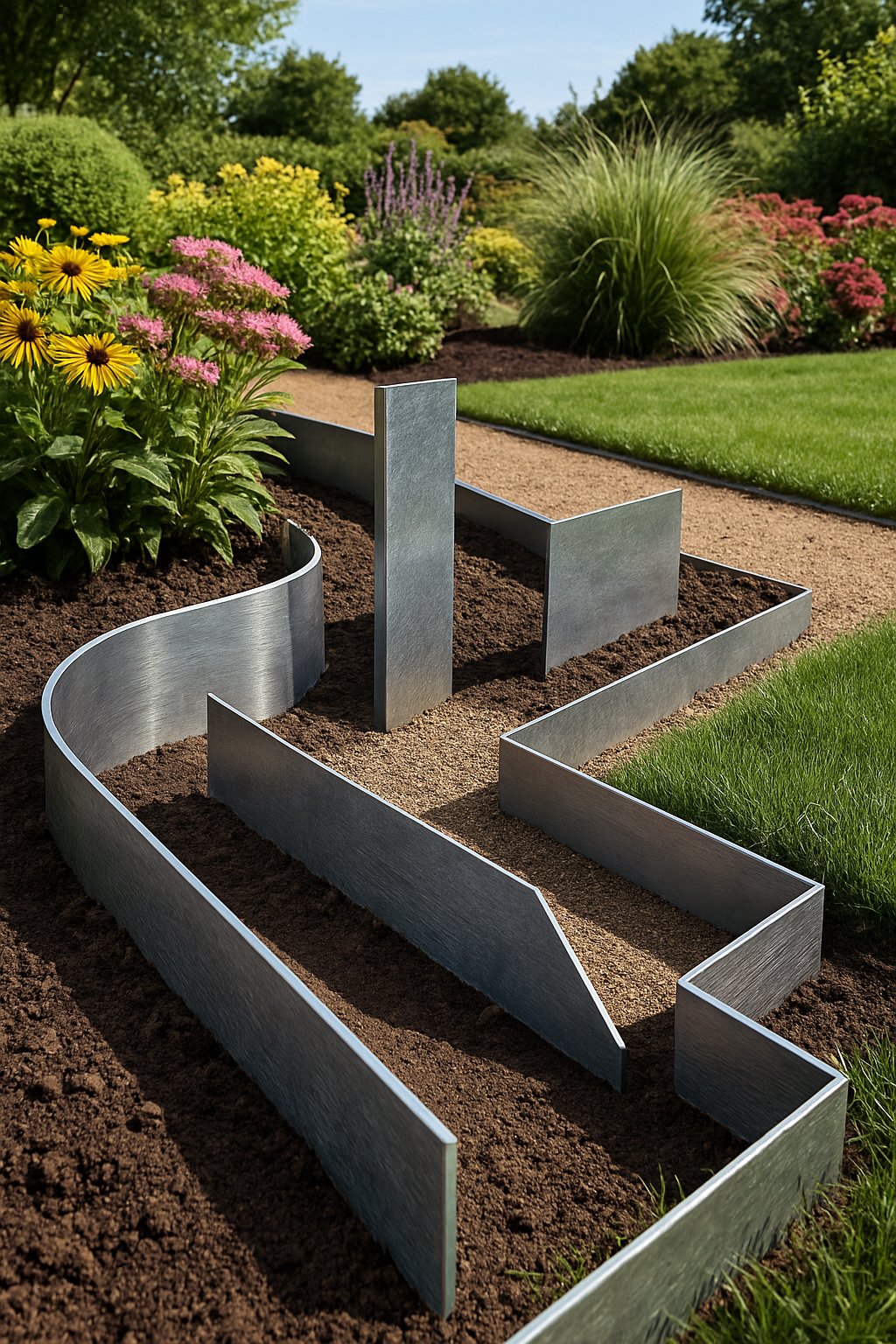
- 𝐃𝐮𝐫𝐚𝐛𝐥𝐞 𝐆𝐚𝐥𝐯𝐚𝐧𝐢𝐳𝐞𝐝 𝐒𝐭𝐞𝐞𝐥...
- 𝐅𝐥𝐞𝐱𝐢𝐛𝐥𝐞 & 𝐄𝐚𝐬𝐲 𝐭𝐨 𝐈𝐧𝐬𝐭𝐚𝐥𝐥: Each 40" long metal edging...
- 𝐀𝐛𝐨𝐮𝐭 𝐭𝐡𝐞 𝐄𝐝𝐠𝐢𝐧𝐠: Enhance your garden's appearance with our 6-pack of 8-inch...
- 𝐃𝐮𝐫𝐚𝐛𝐥𝐞 𝐆𝐚𝐥𝐯𝐚𝐧𝐢𝐳𝐞𝐝 𝐒𝐭𝐞𝐞𝐥...
- "Premium Galvanized Steel, Rust-Proof and Durable: We use a 1.5mm thick heavy-duty steel core to create a sturdy and...
Metal garden edging strips give your garden borders a strong, modern edge. You can pick from steel or corten steel—both resist rust and last for years.
These strips come in different heights and thicknesses, so you can fit them to your garden’s shape. Go for straight lines or smooth curves, whatever you prefer.
Metal strips make everything look clean and keep grass and soil from mixing into your flower beds. They also help stop weeds from spreading.
Installing them is simple. Dig a shallow trench and push the strips in—some even have spikes for extra grip.
Metal is thin but strong, so it won’t hog space or block water. If you want a neat, functional border, this is a solid pick.
Expert Tip from MrPlanter: “Use a rubber mallet to gently tap the metal edging into the ground for a secure fit without damaging the material. Line up each piece tightly to avoid gaps where weeds can grow.”
6. Terracotta Pot Shard Border
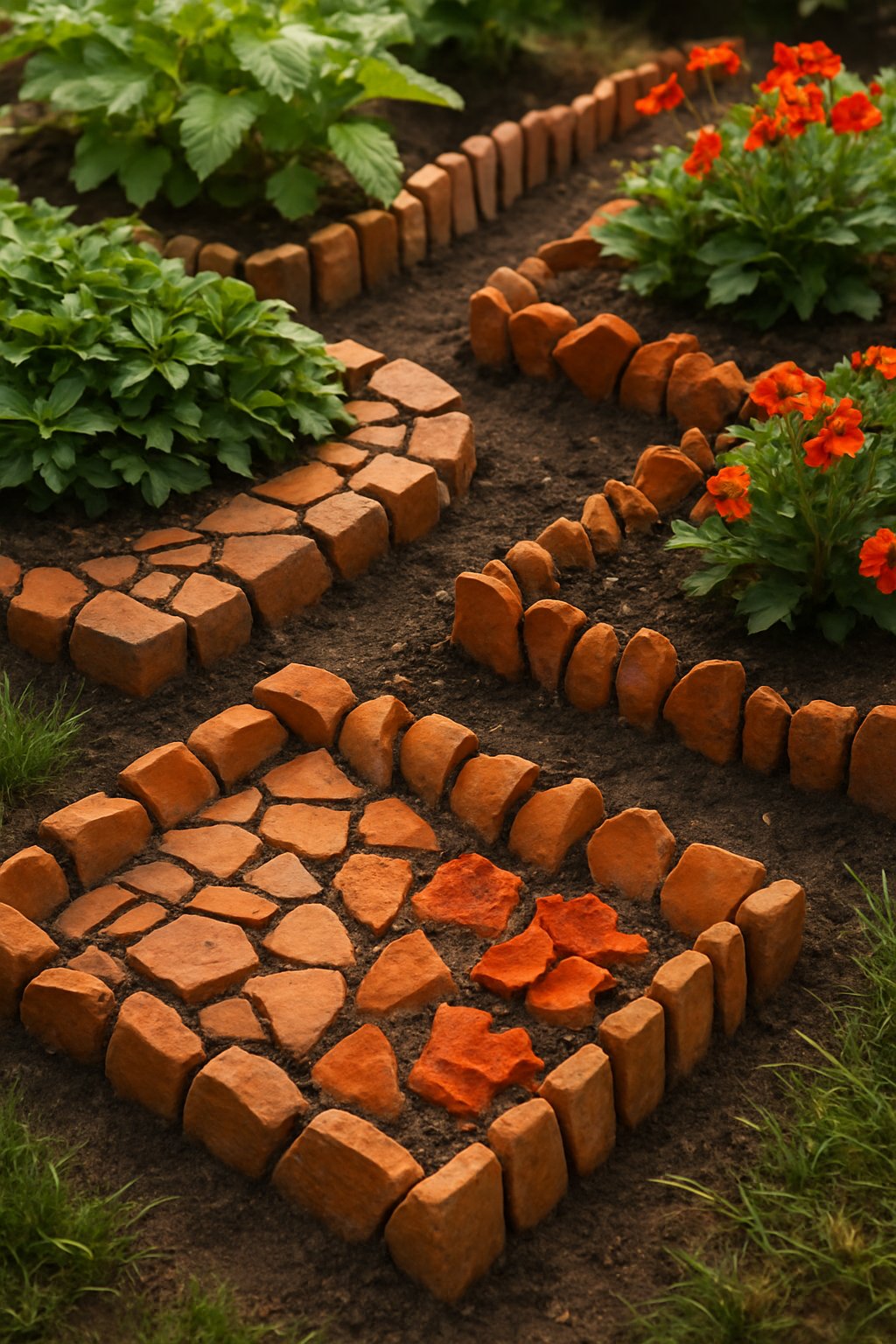
Broken terracotta pots make a unique garden border. Arrange the shards with the points up for drama, or lay them flat for a softer edge.
This adds rustic charm and keeps soil and mulch where you want them. Terracotta shards are easy to get if you have old pots lying around.
They drain well, so you won’t get water buildup near your plant roots. Mix up the shard sizes for a more interesting texture along your border.
Space the shards evenly and push them into the soil a bit to keep things stable. Watch out for sharp edges, though—nobody wants a surprise poke.
Expert Tip from MrPlanter: “Break pots along natural cracks for safer edges. Use gloves when placing shards to protect your hands.”
7. Concrete Landscape Edging

Concrete edging gives your garden beds or paths a clean, solid border.
- EASYFLEX DECORATIVE NO-DIG LANDSCAPE EDGING: Get a beautifully landscaped yard without all the work of a dig-in lawn...
- DO-IT-YOURSELF: Place the edging around raised flower beds, trees, and gardens and use a rubber mallet to drive the...
- Give your concrete slab a finished look and prevent chipping with the contractor-grade QLT Curved End Steel Hand Edger
- Wood Handle: Traditional wood handle offers comfortable grip and control during edging operations
You can shape it to match your garden—keep it simple or go custom if you’re feeling ambitious. Concrete keeps soil and mulch where they belong and blocks grass from creeping in.
You can pour the concrete yourself or hire a pro for a custom look. It’s more permanent than stones or bricks, but still won’t break the bank.
Expert Tip from MrPlanter: “Make sure to seal the concrete to protect it from cracking. Use a level for a smooth and even edge every time.”
8. Decorative Garden Tiles
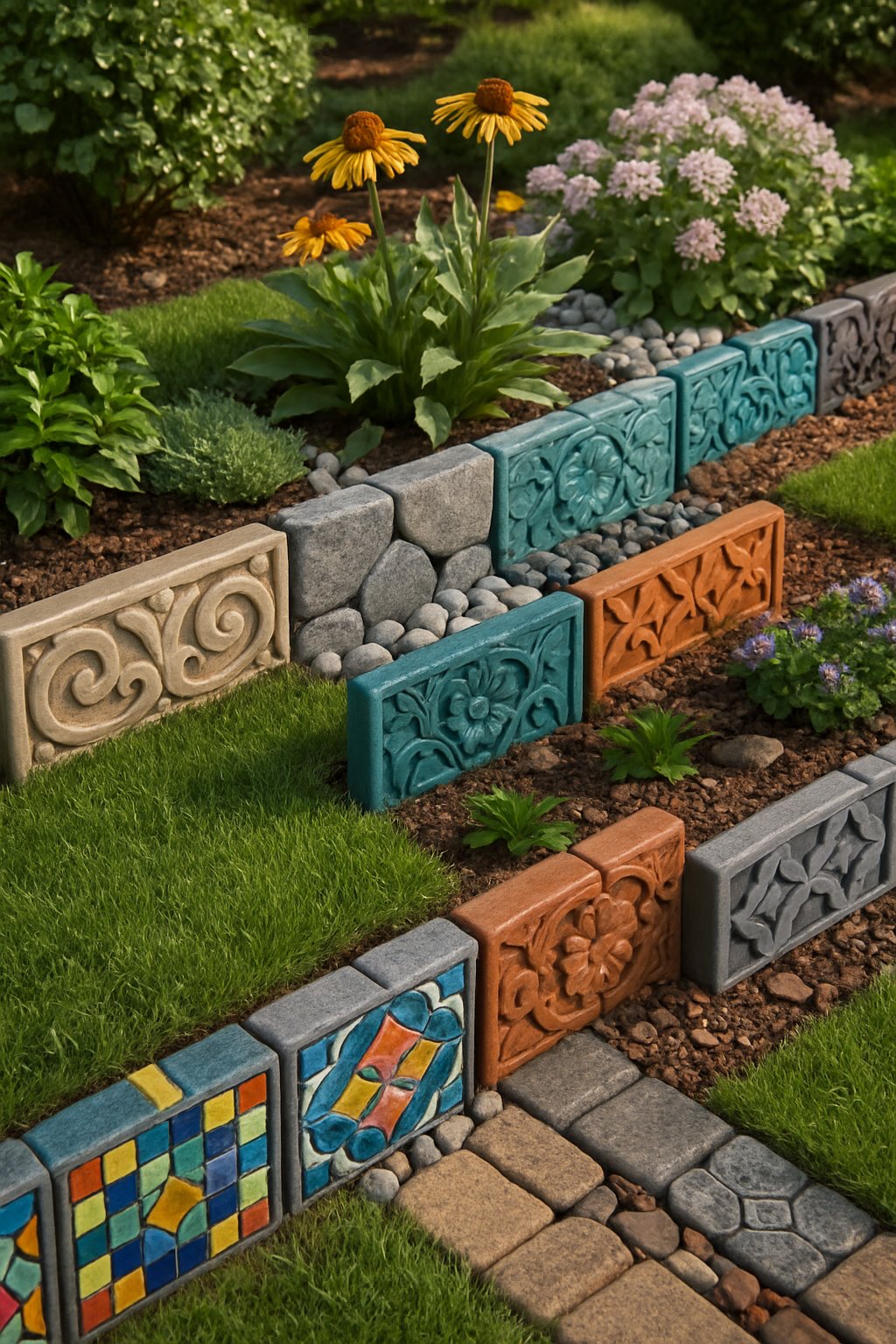
Decorative garden tiles add color and pattern to your edging.
- 𝐏𝐑𝐄𝐌𝐈𝐔𝐌 & 𝐃𝐔𝐑𝐀𝐁𝐋𝐄 𝐀𝐂𝐀𝐂𝐈𝐀 𝗪𝐎𝐎𝐃: THYOI...
- 𝐕𝐄𝐑𝐒𝐀𝐓𝐈𝐋𝐄 𝐈𝐍𝐓𝐄𝐑𝐋𝐎𝐂𝐊𝐈𝐍𝐆 𝐃𝐄𝐂𝐊...
- 【Lightweight but Firm】Made of high hardness plastic. Not as heavy as wooden deck tiles, but has good load-bearing...
- 【Easy Snap Connection】Upgraded interlocking mode can realize faster and safer installation without any tools....
Tiles made from ceramic or stone hold up well outdoors, rain or shine. You can line them up straight or go for a wavy border for a unique look.
Mix tile sizes and colors for a playful edge that stands out. If you want something quick, grab pre-made tile strips—they’re easy to install.
Set tiles on a firm base like concrete or packed soil to keep them steady. This keeps your edge neat and stops things from shifting around.
Expert Tip from MrPlanter: “Pick tiles with a non-slip surface to avoid accidents. Seal them to protect against weather and keep colors bright longer.”
9. Plastic Landscape Edging
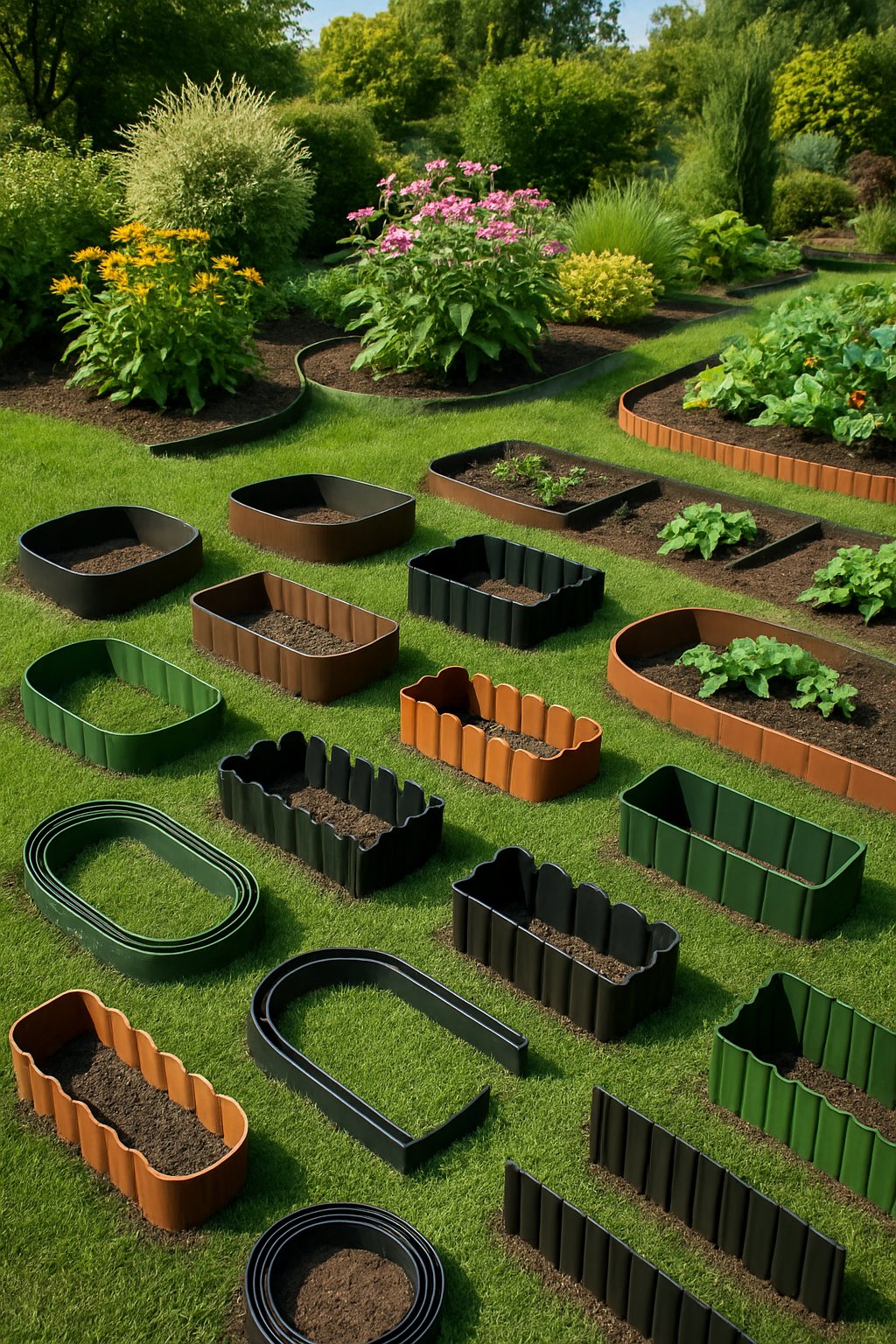
Plastic landscape edging is a go-to for defining garden beds and walkways.
- 【Durable & Flexible Plastic Material】Made of high-quality, weather-resistant rubber, the MIXC garden edging border...
- 【Complete 100FT Landscape Edging Kit with 150 Stakes】The edging border kit includes one roll of 100FT black garden...
- PRODUCT DIMENSIONS:480*2 *2 inches,lawn edging kit suitable for landscape edging,flower garden and grass lawn for the...
- DO IT YOURSELF:the landscape edging kit can help you to create a beautiful flower garden without to hire professionals
This edging is flexible, so you can bend it to fit curves or keep it straight. It doesn’t rust or peel, so it stands up to the weather.
You’ll find plastic edging in different lengths, often with spikes to keep it in place. It’s budget-friendly compared to metal or stone.
Plastic edging keeps mulch, soil, and grass where you want them, giving your garden a tidy look. It works for both small and big spaces.
If you want, you can paint or decorate it to match your style or add a splash of color.
Expert Tip from MrPlanter: “Choose plastic edging with anchoring spikes to avoid shifting over time. Cut it carefully with garden shears for a clean edge.”
10. Natural Stone Pavers
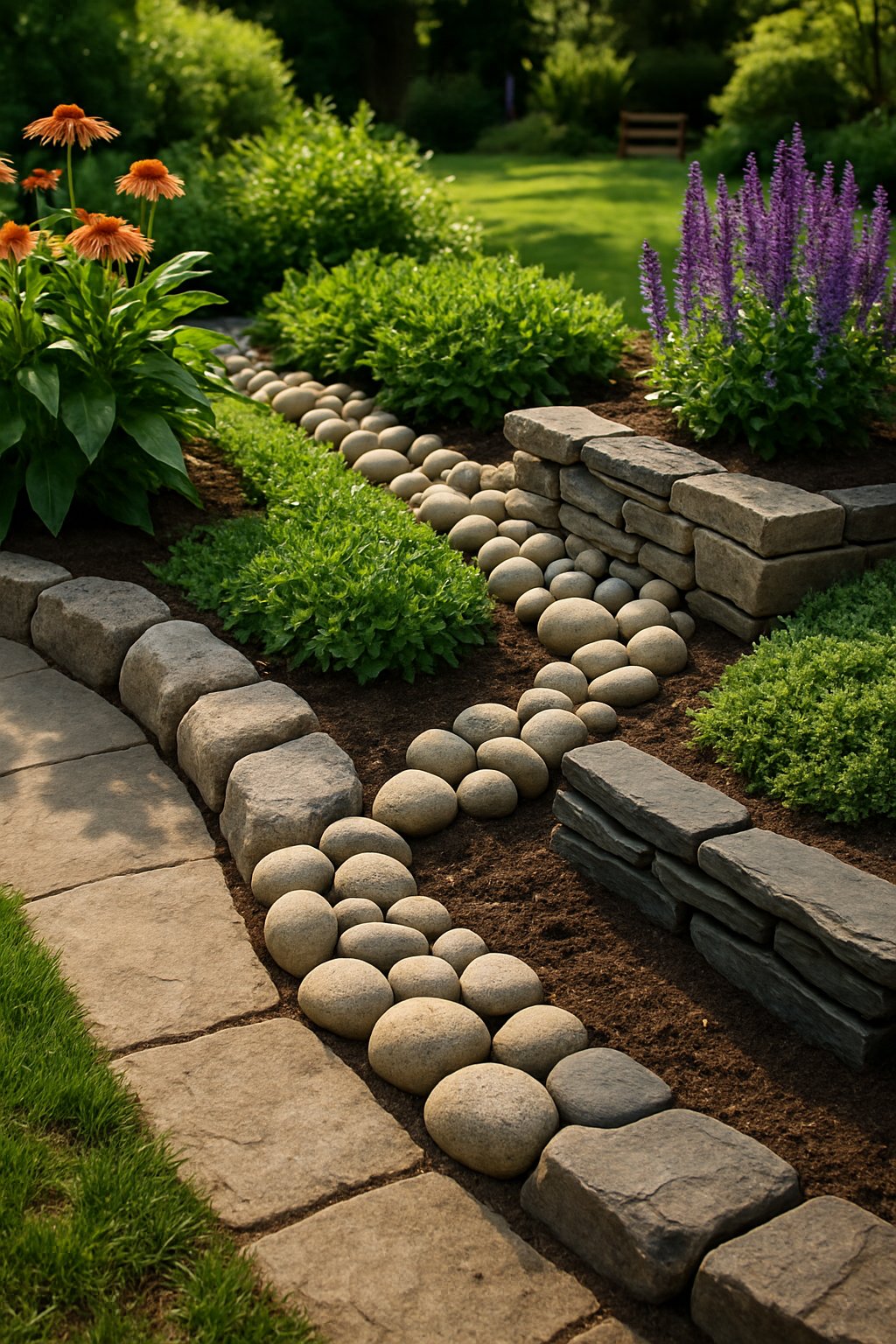
Natural stone pavers give your garden a strong, classic edge. Flagstone, slate, or limestone bring a natural look that fits right in with plants.
Arrange the stones in straight lines or go for a more relaxed, organic pattern. This style works in both modern and rustic gardens.
Stone pavers last a long time and handle foot traffic and weather without much trouble. They also do a great job keeping soil and mulch in place.
You’ll need to level the ground and set the stones firmly, so installation takes a bit of elbow grease. But once they’re in, you don’t have to fuss with them much.
Mixing different stone colors or shapes adds texture and contrast to your border.
Expert Tip from MrPlanter: “Select stones that match your garden’s color scheme for a cohesive look. Seal the stones after installation to protect them from stains and weather.”
11. Low Hedge Shrubs
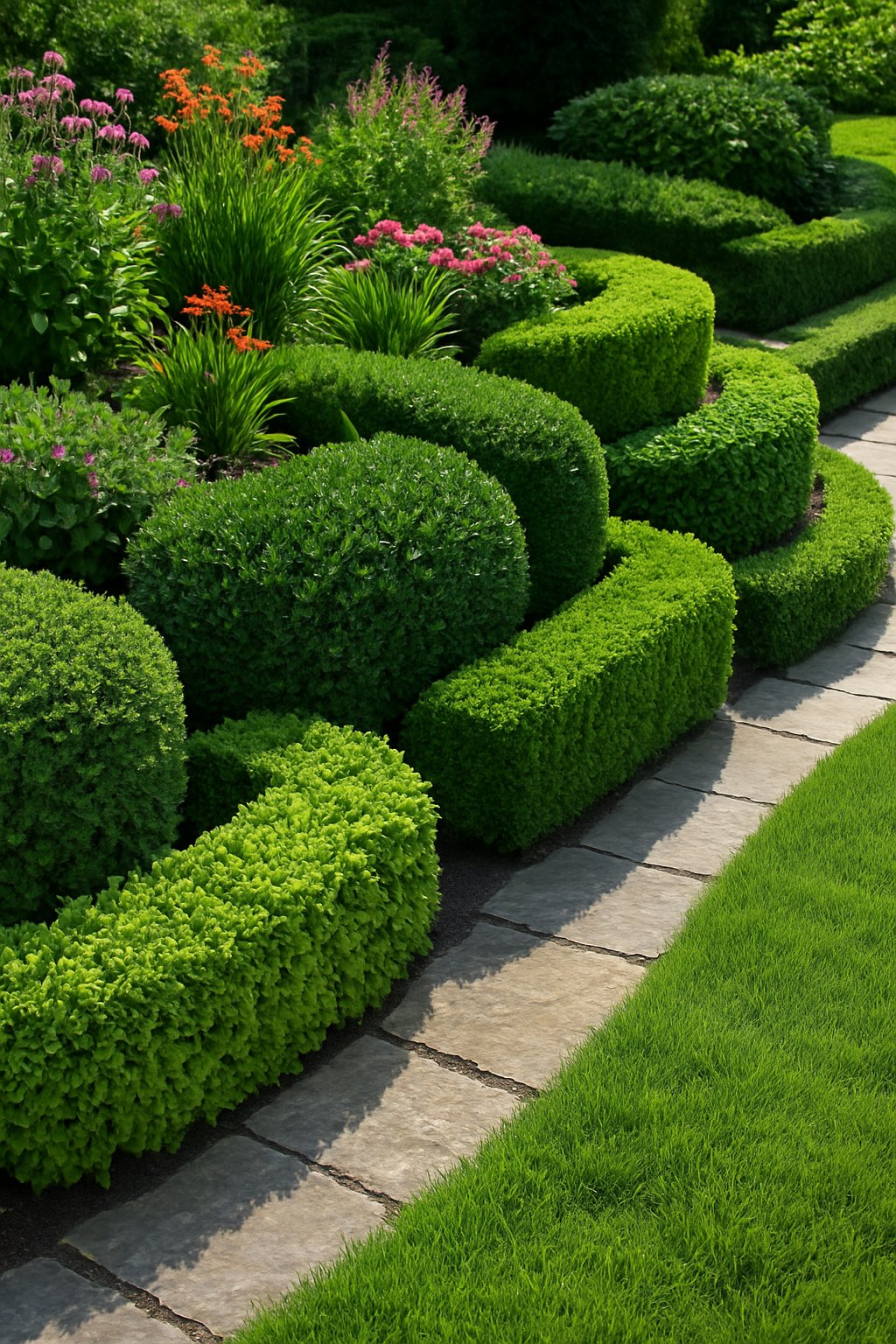
Low hedge shrubs create a natural border for your garden beds. They add a soft, green edge that really blends with flowers and other plants.
These shrubs define spaces without looking too harsh or fake. I think they just make everything feel a bit more put together.
You’ve got lots of choices—boxwood, lavender, or dwarf Japanese holly, to name a few. They stay low, usually under two feet, so you won’t lose your view across the garden.
Low hedges help keep soil in place and cut down on weeds. Not bad for something that looks this good.
Plant them close together to make a neat line. Just trim them now and then to keep the shape tidy.
They look great around pathways or framing flower beds. It’s a simple touch, but it does a lot.
Expert Tip from MrPlanter: “Choose evergreen shrubs to keep your garden edging green year-round. Trim regularly to maintain clean lines and healthy growth.”
12. Stacked Slate Rocks

Stacked slate rocks give your garden edges a sharp, natural look. Their flat, thin layers make it easy for you to stack and shape them along curves or straight lines.
You can build low walls or border flower beds for a clean, modern finish. Slate holds up well in all kinds of weather, so you won’t have to worry about replacing it every year.
The dark tones stand out against green plants or bright flowers. Arrange the stones tightly so they stay put.
This edging works especially well on slopes because the stacked rocks hold soil in place. It also helps you define pathways or separate garden zones.
Mix slate with plants or mulch for a balanced, finished look. It’s a bit of effort, but worth it.
Expert Tip from MrPlanter: “Before stacking, level the ground and lay a gravel base to improve drainage. Tight-fitting stones reduce maintenance and keep your border sturdy.”
13. Pressed Steel Garden Edging

Pressed steel garden edging gives you strong, long-lasting borders. It holds its shape and keeps garden beds neat.
You can bend it easily for curves or keep it straight around your plants. The rust-resistant coating means you won’t have to deal with ugly spots.
It fits both modern and classic gardens. To install, just push it into the ground or use spikes to secure it.
Pressed steel comes in different heights, so you can pick what works for your space. It’s a low-maintenance choice that doesn’t crack or break like some other materials.
Expert Tip from MrPlanter: “Make sure to clean the edging regularly to avoid dirt buildup. A simple wipe keeps it looking new and prevents early wear.”
14. Gray Cobblestone Path Border

Gray cobblestones give your garden paths a clean, classic edge. They separate grass from walkways and keep your lawn looking sharp.
The natural stone adds a timeless touch that works with nearly any garden style. You can lay the cobblestones in a straight line or curve them gently.
This adds texture and structure to the space. The stones are tough and handle weather changes with barely any fuss.
To install, dig a shallow trench along your path, set the stones, and use sand or soil to hold them in place. They help guide people along the path and make your garden look neat.
Expert Tip from MrPlanter: “Choose cobblestones that match your garden’s color palette for the best look. Use a level when placing stones to keep the border even and stable.”
15. Upcycled Pallet Wood Edge
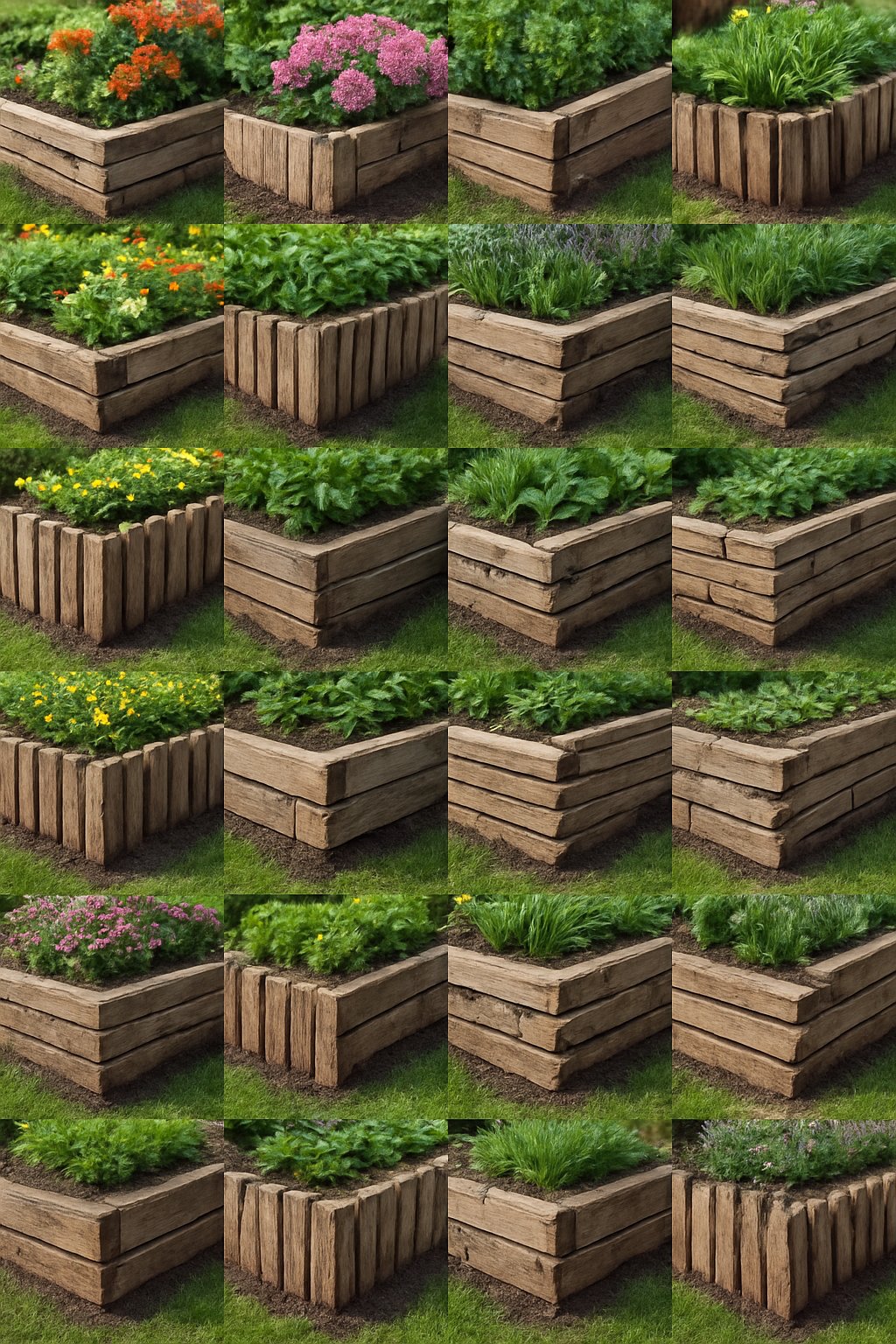
Using pallet wood for garden edging is a clever way to recycle old materials. Pallets are easy to find and usually cost nothing or just a few bucks.
Cut the wood into boards or shapes that fit your garden’s style. Pallet wood brings a natural, rustic vibe that works with lots of different looks.
It’s sturdy enough to hold soil and mulch in place. You can stand the boards up, lay them flat, or even make zigzag patterns.
Before you start, pull out any nails or staples. Give the wood a light sanding so you don’t get splinters.
Treating the boards with a sealant helps protect them from weather. You can paint or stain them for extra color and style.
That way, your garden edge stands out and lasts longer. Pallet wood edges are easy to install and you can move them if you want to change things up later.
Expert Tip from MrPlanter: “Always check pallets for chemical treatments before using them in your garden. Sand and seal the wood to extend its life outdoors.”
16. Masonry Block Border

Masonry blocks offer a strong and simple way to edge your garden. They create a clean, straight line that holds soil and mulch right where you want it.
You can stack them one or two blocks high for a low wall effect. These blocks come in lots of colors and textures, so you can match your garden’s look.
They’re durable and hold up well over time. Arrange them in straight rows or curves—whatever works for your space.
To install masonry blocks, dig a shallow trench, level the ground, and place the blocks side by side. Add gravel underneath for better drainage and to keep them from moving.
This edging fits vegetable gardens, flower beds, or pathways. It’s practical and neat, giving your garden a finished feel.
Expert Tip from MrPlanter: “Use a rubber mallet to gently tap blocks into place for a snug fit. Seal the blocks with a concrete sealer to keep them looking fresh longer.”
17. Edging with Boxwood Plants

Boxwood plants make fantastic natural edging for beds or pathways. They grow dense and stay green all year, so your borders always look tidy.
You can easily shape boxwoods with regular trimming. Keep them low for a neat border, or let them grow taller if you want more privacy.
Boxwoods are deer resistant, so they’re a good pick if wildlife wanders through your yard. They handle different weather pretty well too.
Plant them close together to get a solid line. Water regularly, especially when they’re new, so they settle in strong.
Expert Tip from MrPlanter: “Choose smaller boxwood varieties for tight spaces. Regular trimming keeps your edges sharp and the plants healthy.”
18. Curved Metal Edging
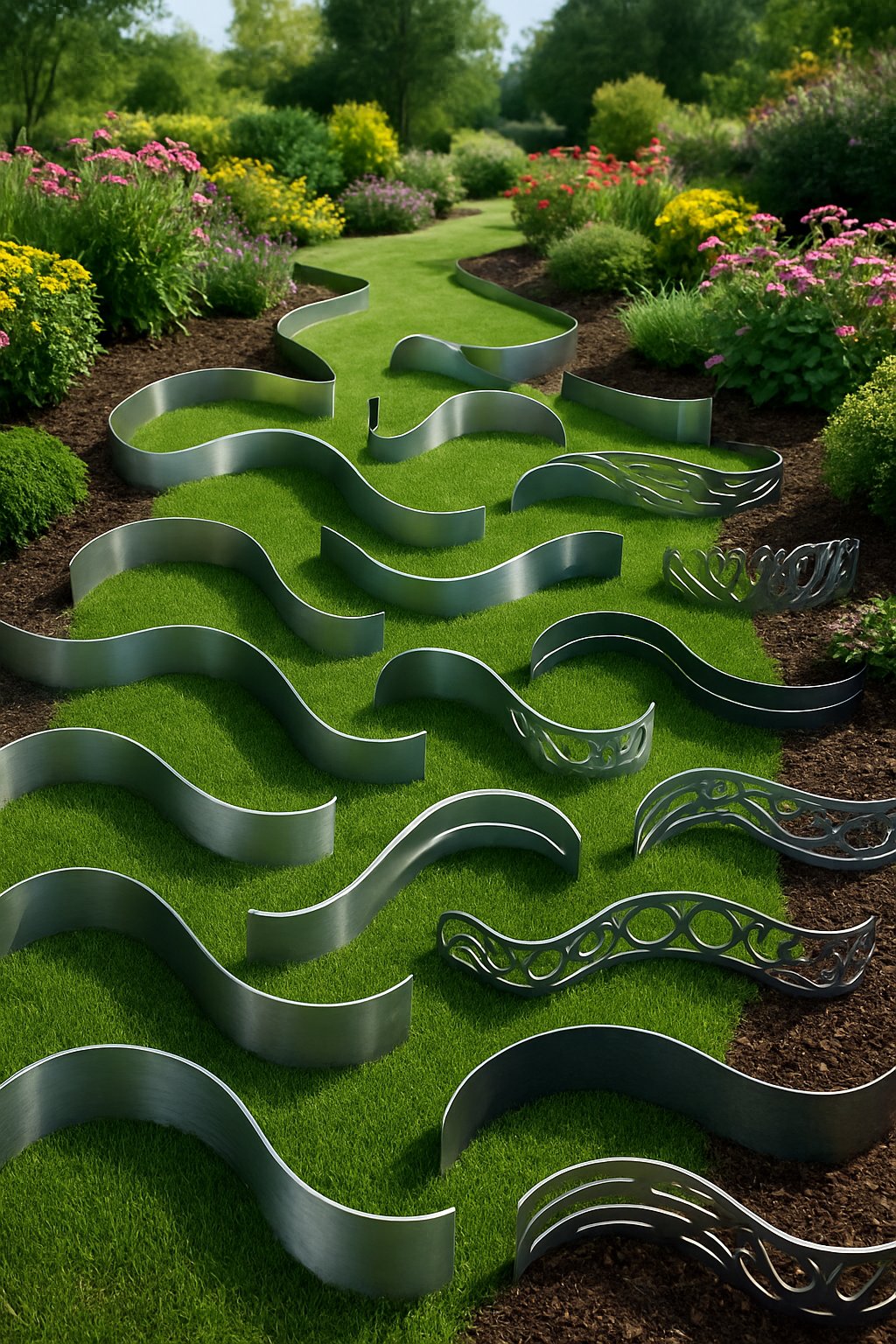
Curved metal edging brings a smooth, flowing look to your garden beds. It’s perfect if you want gentle, natural shapes instead of straight lines.
Manufacturers make this edging from flexible steel or aluminum. You can bend it to match your design without damaging the metal.
Metal edging is strong and will last for years. It holds soil and mulch in place and gives your garden a clean, modern vibe.
It’s also low maintenance. You won’t have to worry about rot like with wood.
Use a mallet and stakes to secure the edging in the ground. That keeps your curves neat and stable, even after a big rain.
Pick rusty or black-finished metal for a cool contrast with your plants. It adds some character, don’t you think?
Expert Tip from MrPlanter: “Before shaping the metal, lightly mark your curve on the ground. This helps keep your design smooth and even throughout the installation.”
19. Gabion Stone Baskets

Gabion stone baskets are wire cages filled with rocks, and they make garden edging that’s both sturdy and stylish. They give a modern, natural look and help you hold back soil or define spaces clearly.
You can fill the baskets with different stones to match your style. They’re easy to build and last a long time with little upkeep.
Gabion baskets help with drainage, so they work well on slopes or near wet spots. Stack them for height or line them up for a clean edge.
These baskets add texture and a bit of contrast, making your garden more interesting. They’re eco-friendly too, since you’re using natural materials that just fit outdoors.
Mix gabions with plants or even lights for a border that really stands out. It’s a fun way to get creative.
Expert Tip from MrPlanter: “Choose stones that complement your home’s color for a unified look. Fill baskets tightly to keep stones from shifting over time.”
20. Sandstone Blocks
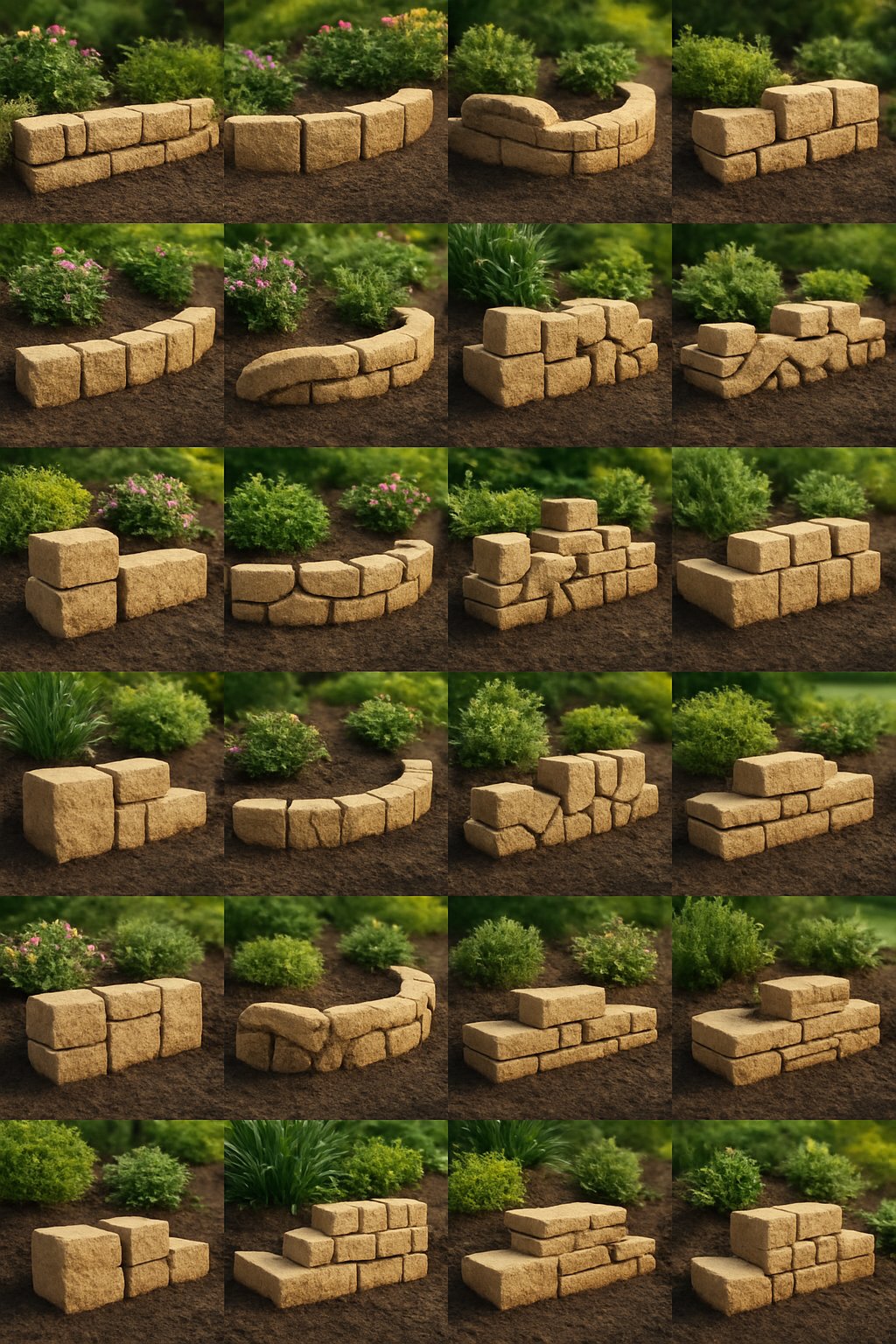
Sandstone blocks make a strong, natural choice for garden edging. Their warm colors add a soft, earthy look that works in just about any garden.
You can lay them in straight lines or curves for clean borders. These blocks hold up well in all kinds of weather.
They help keep soil and mulch where you want them, and they add texture to your beds. Sandstone is easy to stack, so you can use it for low borders or taller raised beds.
Mix up the block sizes for a more relaxed, natural edge. If you want a simple but stylish look, sandstone gives you a classic, timeless finish.
Expert Tip from MrPlanter: “Place sandstone blocks directly on firm soil to prevent shifting. Use a level as you lay them for an even, neat border.”
21. Flower Pot Border Edging
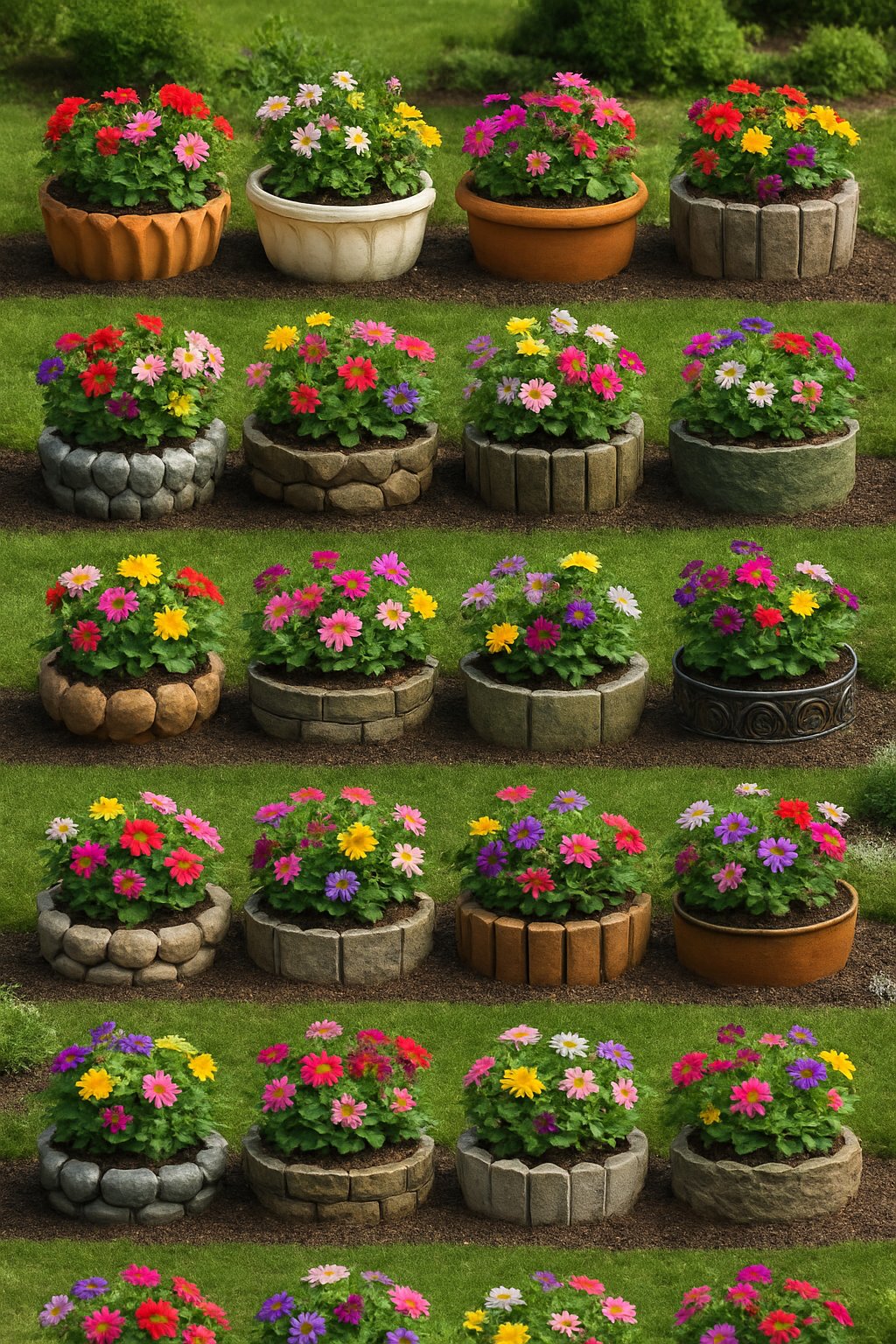
Using flower pots as garden edging gives you a unique, colorful border. Place pots upside down or right side up along paths or flower beds to clearly separate spaces.
Choose pots that match your style—classic terracotta or bright painted ones both work. Fill pots with small plants or flowers to add extra life to the edge.
This edging is easy to move or change, perfect if you like switching things up now and then. Just make sure the pots are stable so they don’t tip over.
You can use pots of different sizes for a more varied look. Line them up close or space them out for different effects.
Expert Tip from MrPlanter: “Pick lightweight pots for easy rearranging, but add gravel inside to keep them steady. Use vibrant flowers in the pots to brighten dull edges.”
22. Edging with Bamboo Stakes

Bamboo stakes make a garden border look natural and simple. I like how lightweight they are, and honestly, you can cut or adjust them pretty easily to fit any garden shape.
You can set the stakes close together for a solid edge, or just leave a few gaps if you want a more open vibe. Bamboo is affordable and somehow just fits in with the plants around it.
Push the stakes firmly into the ground so they stand up straight. Over time, bamboo weathers, but if you take care of it, it’ll last for several seasons.
Try treating bamboo with a sealant if you want to avoid cracking or rotting. I find this type of edging works best for smaller flower beds or maybe a veggie patch.
Bamboo adds a unique, eco-friendly touch, and you won’t need fancy tools to put it in.
Expert Tip from MrPlanter: “Choose thicker bamboo stakes for better durability. Seal your bamboo edges annually to keep them looking fresh and strong.”
23. Decorative Gravel Edge
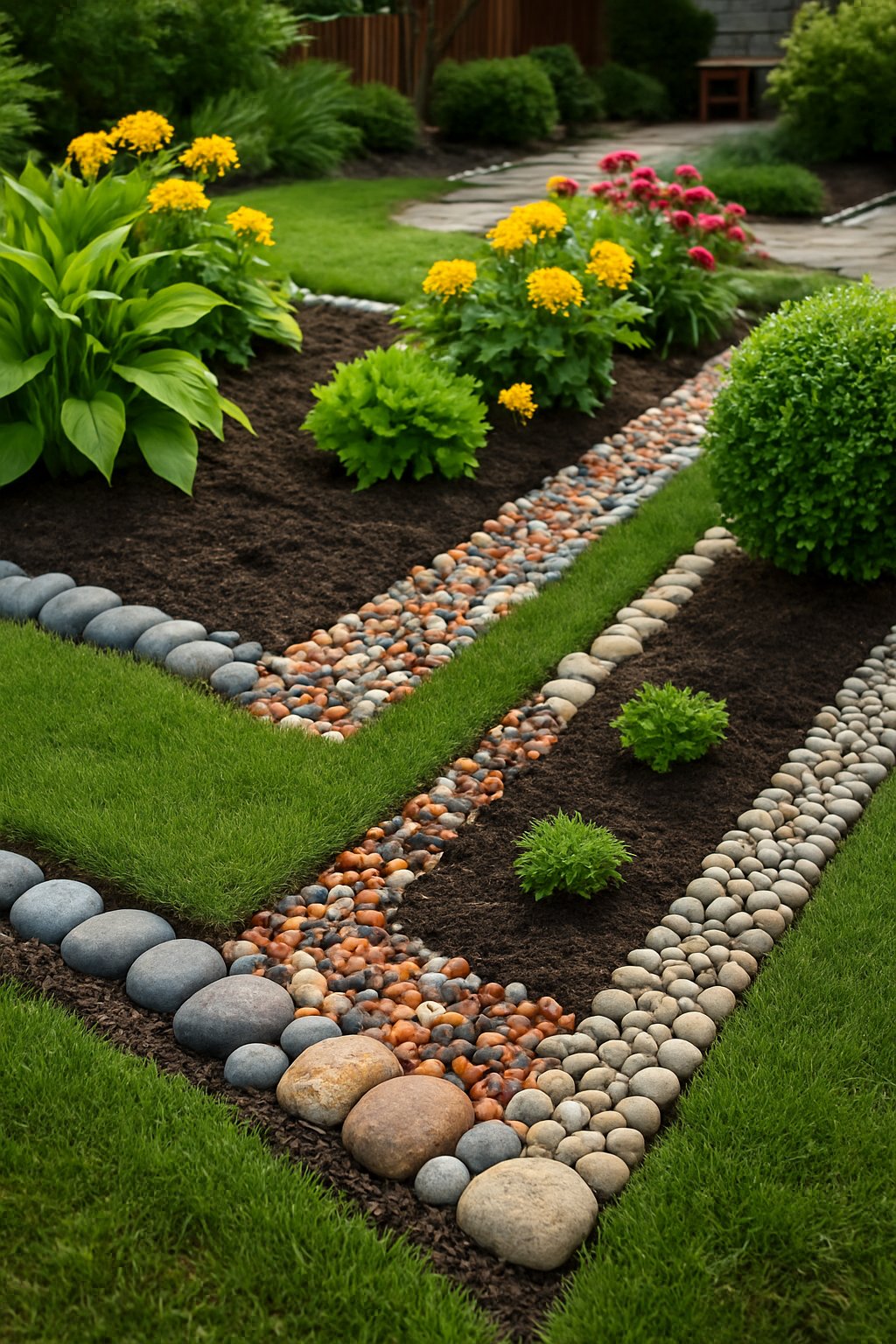
Decorative gravel makes garden edging a breeze and adds a bit of texture and color. Gravel forms a tidy border that keeps soil and mulch where they belong.
It also lets water drain well, so you won’t get puddles around your plants. You can pick gravel in all sorts of sizes and colors, which is nice if you want to match your garden’s style.
Light-colored stones brighten up dark soil, but darker gravel gives you a more subtle contrast. I think this kind of edging looks great along paths, flower beds, or even circling a tree.
Gravel edging barely needs any maintenance. Just top it up now and then, and use an edging barrier to make sure it stays put.
It’s a budget-friendly option that works with lots of different garden designs.
Expert Tip from MrPlanter: “Use a weed barrier under your gravel to stop unwanted plants from growing. Choose gravel size based on the look and feel you want for your garden edge.”
24. Steel Lawn Edging Fence
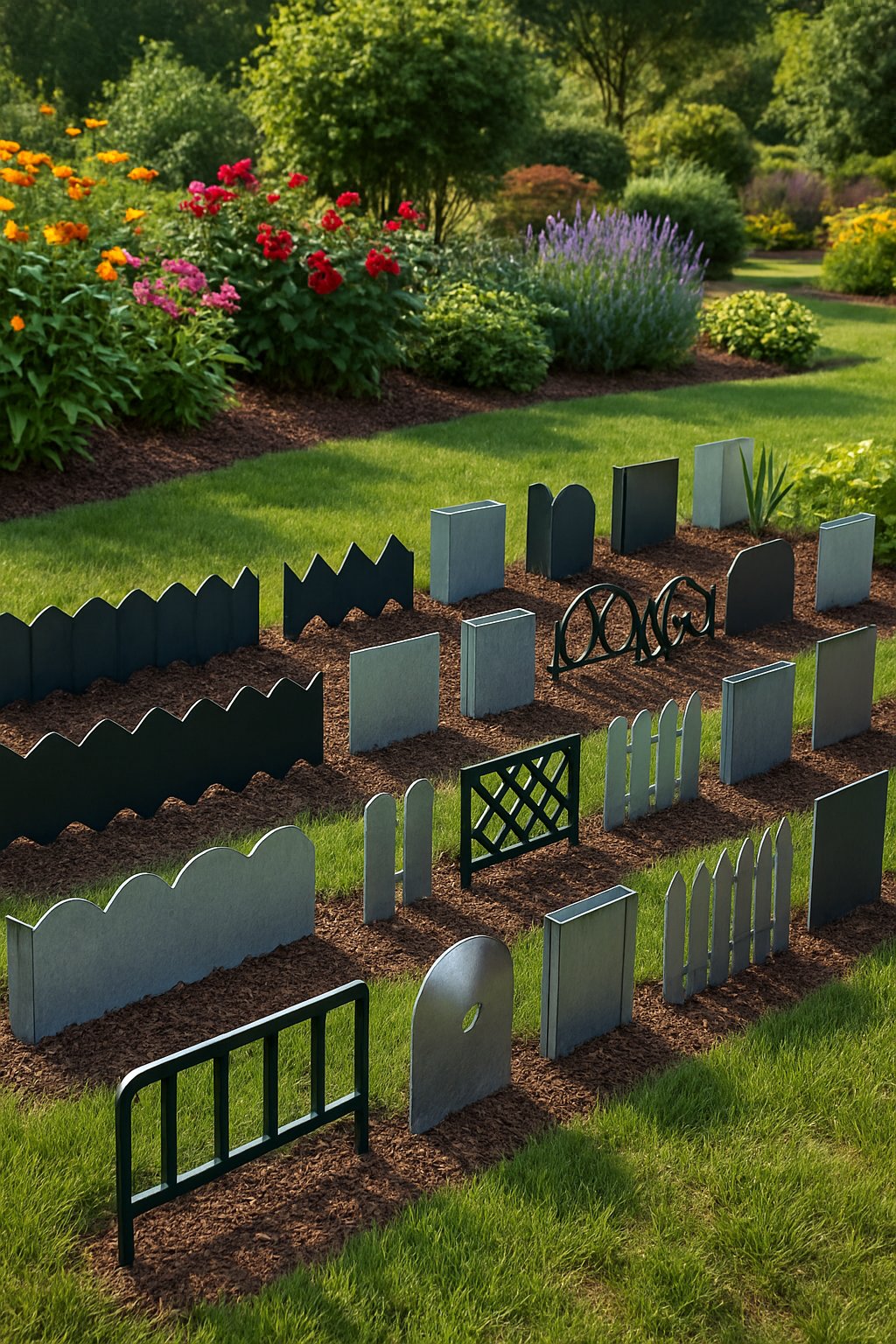
Steel lawn edging fences give your garden those crisp, sharp lines that just look so tidy. They create a solid barrier between your lawn and flower beds, so grass and soil won’t mix.
Steel edging lasts a long time, and it’s tough enough to handle rough weather. It doesn’t really bend or break unless you try pretty hard, and with a protective coating, you probably won’t see any rust for years.
You can bend steel edging into curves or keep it straight, depending on your garden style. It’s flexible, so you get plenty of options for shaping it around flower beds or along winding paths.
Installing it is pretty straightforward. Just push the edging into the ground—sometimes you might want to use stakes for more support.
It keeps soil where you want it and blocks grass from sneaking into your flower beds. That alone saves a lot of hassle.
Steel edging fences come in all sorts of heights and colors. You can pick something that fits your garden vibe, whether you like the natural metal look or want a painted finish.
Expert Tip from MrPlanter: “Choose steel edging with a rust-resistant coating for longer life. Use a rubber mallet to gently tap the edging into firm soil without bending it.”











